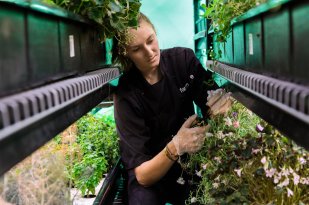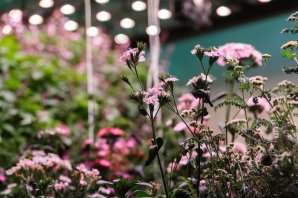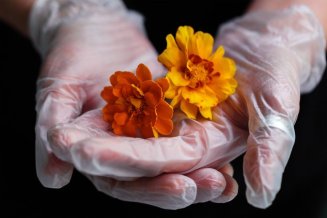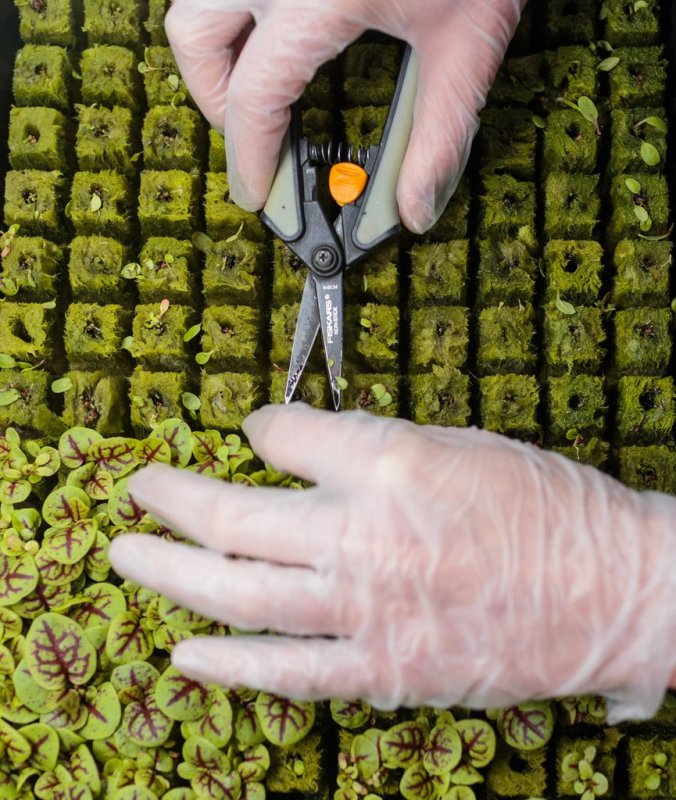
At Farm.One, a hydroponic garden in TriBeCa, red-veined sorrel is prepared for a delivery. Credit Sarah Blesener for The New York Times
We have posted on urban farming and related topics numerous times since 2011, and hydroponics as its own topic of interest plenty of times as well. Culinary and/or gastronomic topics as related to agriculture are a magnitude of order more represented in these pages. Finally, they are combined for us in one amazing article, thanks to Alyson Krueger. If you only have time to look at the photos, those alone are worth the click:
Herbs From the Underground
Farm.One just opened an indoor rare herb and flower garden in a TriBeCa basement, and many prominent chefs are flocking to it.
Katherine Chester, a farm hand at Farm.One, harvests for a morning delivery. Credit Sarah Blesener for The New York Times
In the basement of a loft-style building in TriBeCa that houses a vet, a dog swimming pool, an eye-and-ear infirmary, and a two-Michelin-starred restaurant, there is a working farm.
Farm.One is a hydroponic facility, which means that the plants do not grow in soil. Many of these farms are located indoors, in controlled environments, with artificial lighting.
Amazon neon cherry dianthus and neon rose magic dianthus. Credit Sarah Blesener for The New York Times
The new two-room space, which opened in November in a former cycling studio for high-altitude training and an old storage area, is only 1200 square feet. There is no fresh air or natural light; there is not even a window. Yet the venue can grow around 580 varieties of rare herbs and flowers (200 at a time) that supply New York’s top restaurants. Le Turtle, Le Coucou, Mission Chinese Food, and The Pool get regular deliveries from Farm.One, sometimes several times a week.
“I wouldn’t want to pay for a space with great retail frontage,” said Robert Laing, the farm’s chief executive and founder. “All we need is a floor drain, water, power, temperature control, and the ability to seal the space so bugs don’t get in.” The farm does deliberately bring in a few types of insects that are beneficial for plants, like ladybugs. “You can buy them on Amazon,” he said.
Seeds are planted in materials like coconut husks and are put in a tray so water and nutrients can circulate below them. LED lights above simulate the sun. Growing time is not long; many plants, like microgreens, are ready in a little over a week.
People who find it weird to eat food grown in a basement have no reason to worry, said Neil Mattson, associate professor and greenhouse extension specialist at Cornell University. “There is nothing icky about it. Plants don’t care whether they get light from the sun or the lamps. It’s the same thing.”
Anise hyssop flowers. Farm.One can grow some 580 varieties of rare herbs and flowers. Credit Sarah Blesener for The New York Times
Matthew Hyland, the chef and owner of Pizza Loves Emily, a client of Farm.One, agreed. “A hydroponic garden in general is an amazing thing,” he said. “It’s lit nicely; it smells good in there; the temperature is nice; everything about it is very pleasing.”
The plants grow on shelves that can be expanded or contracted like the stacks in a university library (this setup almost doubles the growing space.) On one level there might be anise hyssop, an herb with tiny lavender-colored flowers and square stems that tastes strongly of mint and licorice. On another, mustard green, a plant that tastes a lot like spicy horseradish. The colors are so diverse and vibrant that the head horticulturalist, David Goldstein, has taken to arranging them on trays for parties.
Mr. Laing, a British-Australian entrepreneur with a sharp sense of humor, can walk around the farm and tell you exactly what every variety is and to whom it is being delivered. “This is my favorite,” he said, pulling off a leaf of papalo. “Crush it up a little bit in your hand and smell it first — there is cilantro, citrus peel. It’s super fresh and quite grassy.” He paused. “I never want to sell software again.”
In a previous life, Mr. Laing worked in Japan, where he started a translation software company. After eight years he turned his attention to his true passion: food. He took culinary classes and visited farmers’ markets across the world, discovering many rare herbs he had never heard of along the way. “And I was someone I thought knew about food,” he said. So he started researching ways to bring these herbs to chefs.
Farm.One grew out of this research. In April 2016 the new company started growing products at a small indoor farm at the Institute of Culinary Education, also in Lower Manhattan, on Liberty Street. By August, the farm had its first client: Daniel Boulud’s Daniel. By the end of the summer, the herbs had sold out, which led Farm.One to open a second location this fall, at 77 Worth Street.
For $50, New Yorkers can take a tour of the farm, tasting dozens of rare flowers while sipping a glass of prosecco, and they are given a box of herbs to take home. Farm.One also offers seminars on the basics of hydroponics, and any herbs and flowers not snapped up by chefs are available for purchase through its website. Mr. Laing is discussing bringing the farm to other cities.
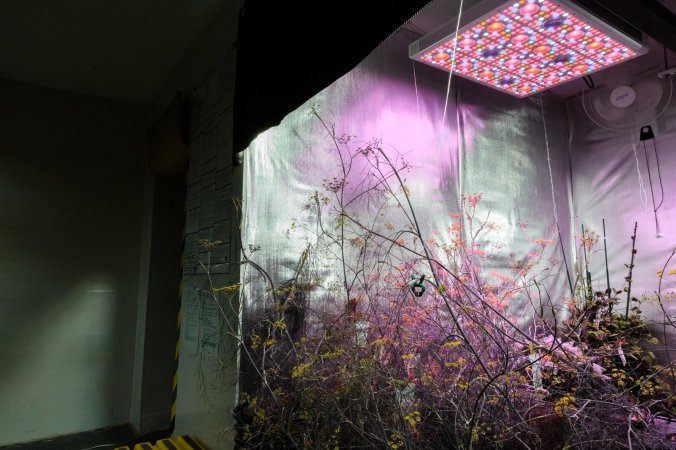
The harvest room at Farm.One. Credit Sarah Blesener for The New York Times
Read the whole story here.
